Peak Design Travel Tripod Review
Introduction
The Travel Tripod from Peak Design is the first innovative tripod of the decade. This relatively lightweight tripod extends to full-size while folding down into an exceptionally compact form. Its uniquely designed legs and central column maximize how tightly it folds, resulting in a rather dense package with little wasted space. An equally unique ballhead comes with the tripod and slots itself cleverly against the hub that joins all three legs and the central column together.
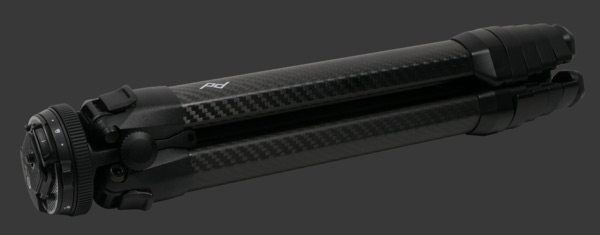
Peak Design equipped their tripod with a number of built-in accessories. The previously mentioned ballhead ships with all their tripods. It features a built-in bulls eye spirit-level and an Arca-Swiss quick-release clamp with a compatible ultra-low profile plate. The clamp also works with an included universal cellphone holder. A special tool and leg-attachment holster is also included to keep it handy. Finally, Peak Design also provides a padded waterproof tripod sleeve, albeit with no strap since they sell those as separate products already. An optional Universal Head Adapter is sold separately as well.
There are actually two versions of this Travel Tripod. One features Carbon Fiber legs, the other Aluminum ones. The central column is Aluminum on both variants. The Carbon Fiber model weighs in at 1.3kg or 2.8lbs, while the Aluminum is 1.5kg or 3.4lbs. This article reviews the Carbon Fiber Peak Design Travel Tripod with and without the Universal Head Adapter. Ergonomics of the aluminum model are identical.
Design
Tripods are rather simple equipment. They consist of 3 legs which gives them their name and stability. Often, but not always, there is a central column to reach higher without adding much bulk to the tripod. Most tripods support a wide variety of heads via a standard 3/8" screw. Even though many are sold with an included head, it is replaceable on most tripods.
Given this simple concept, changes in tripod design are rare. The previous innovation, a tiltable column trading stability for versatility, is already over a decade old. Peak Design created the next tripod revolution with trapezoid legs that pack tightly against a triangular central column. Great thought was put in its design which includes many unique elements, yet its compactness alone is reason enough to buy this tripod. For those who consider packing-size the most important, just go ahead and buy one directly from Peak Design. Keep reading this review while waiting for your order because it covers all its features and quirks.

Legs
Each leg is made of 5 interlocking tubes which are released manually with concentric levels. These levers are curved and precisely aligned to open all of them on each leg in one movement. They close down tightly and prevent any slippage. Each leg is capped with a rubber foot that can be replaced with spikes which are sold separately. The other end of each leg has a spring-loaded lever that allows it to open more than the default in order to place the camera lower.
The trapezoid tubing that forms most of the leg has a very smooth finish. There is a visible weave typical of Carbon Fiber yet it has no texture. These leg tubes appear extremely study. Inner tubes a bit narrower than necessarily, culminating in a very skinny tube at the bottom. It still fees quite solid though. When fully closed, this tripod folds down to 39.5cm or 15.6".
NOTE Neocamera performed their own measurements for size and weight since those provided by Peak Design are inconsistent. For this reason, they differ slightly from some official ones. All measurements are rounded to one decimal place.
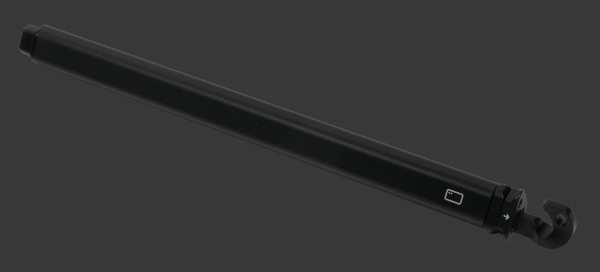
Central Column
A triangular central aluminum column allows the tripod to reach 1.52m or 60" high, compared to 1.3m or 51" with the column completely down. As always, the tripod provides far more stability with the column down. Keep this point in mind until the usability section of this review. Since the central column is not round, it cannot rotate to reorient the camera without loosening the head. A circular knob on the hub of the tripod is used to lock the column in place. Even fully down, there is a bit of wiggle, so make sure the knob is completely tightened before take photos or videos.
The central column has a unique design that contributes to the compactness of the Peak Design Travel Tripod. This triangular shape allows its legs to get really close, make the tripod close down to 8cm (3") is diameter, certainly the greatest achievement of the Peak Design Travel Tripod. The column also serves as a mounting-point for the supplied head. Instead of attaching to the top, Peak Design blended their original head with part of the column. This is exactly why the Universal Head Adapter is needed to use standard tripod heads. The adapter is a miniature column with a top-plate that has a 3/8" screw to mount a traditional head.
At the very bottom of the central column, there is a plastic hook to weigh the tripod down for added stability. This hook features a small hole to attach a Peak Design Anchor in order to use one of their straps. An neat mechanism allows this hook to be detached easily by pulling and twisting, although it appears to be the least sturdy component. Once the hook is out, it is possible to invert or remove most of the central column.
Without the central column, the bottom part of the head or the Universal Head Adapter remains uncapped, so it could slip out if the central knob is not completely tight. Unfortunately, the hook cannot be attached directly to the head or adapter as safety to prevent that from happening, as it normally does. In case this is not obvious, there is no way to attach a strap to the tripod when the central column is removed.
Inside the central column, there is a collapsed bracket that can be used to hold almost any cellphone directly onto the quick-release clamp. This clever design makes this accessory take no space at all! This bracket is made of two spring-loaded interlocking tubes and a foldable clamp on each end. The inner spring is strong enough to grip on any phone tightly.
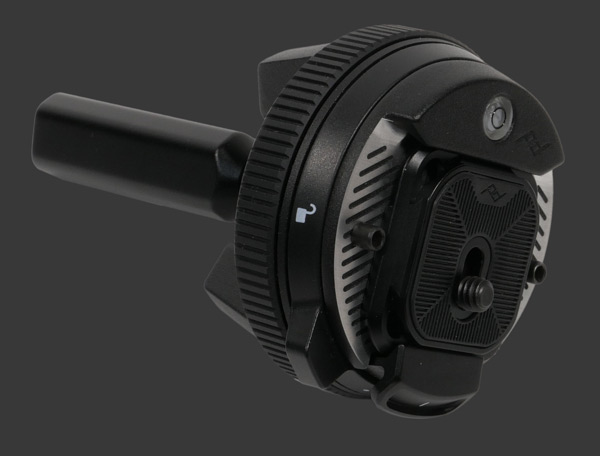
Ballhead
All Peak Design Travel Tripods come with a very unusual ballhead that is mostly hidden when the tripod is collapsed. This compact head has its ball at the top of an extension to the central column with the entire mechanism above it. A single ring around the base of the quick release clamp serves to immobilize the head. Turning it clockwise tightens and counter-clockwise allows the head to be tilted in any direction. It has an impressive range of motion, up to 90° in most directions.
A quick-release clamp is built into the supplied ballhead. A ribbed metal base is flanked by a wide fixed edge and a smaller spring-loaded mechanism to secure an Arca-Swiss plate. The majority of such plates should be compatible but Peak Design provides their own ultra-low profile universal plate. Arca-Swiss plates are often camera-specific but the one provided works with any camera having a standard tripod-mount. While this quick-release clamp holds the plate securely on two sides, there is some wiggle-room with the provided plate, making it difficult to center the camera. Pins on both sides are just a few millimeters too far part. To accommodate larger plates, those can be removed.
There is a miniscule spirit-level on the fixed side of the quick-release clamp. Its small size and the fact that it is untinted make it very difficult to read. The bubble inside the level is incredibly small and hard to see without being directly above it. While the level is there for photographers to confirm that the head is level, the level is almost always obstructed once a camera is mounted.

Tripod Bag & Tools
A waterproof padded tripod bag comes with these tripods. The bag fits snuggly the tripod with the standard head completely closed down or the Universal Head Adapter with no actual head attached. The bag itself is very high quality with a waterproof zipper. A strip of flexible plastic runs between two hoops that can be used to attach Peak Design Anchors. This allows one of their straps to be attached but none is supplied when purchasing the tripod. Considering how expensive the tripod and Peak Design straps are, this is disappointing. Pass though spaces below the plastic strip can be used for other types of straps.
With many custom designed parts, this tripod requires special tools to be modified and perform maintenance. Each of the tripod and Universal Head Adapter comes with their own dual-sides hex-key. The foldable one shipped with the tripod can be held by a miniature holster that attaches to a tripod leg or stored in a inner pocket of the tripod bag. When the tripod is handled roughly, the tool could fall out of its holster but it seems mostly secure. It did fall out at least once during the review period, so it is probably best to keep it away. The only frequent need for one of these tools is for the supplied quick-release plate which requires a hex-key.
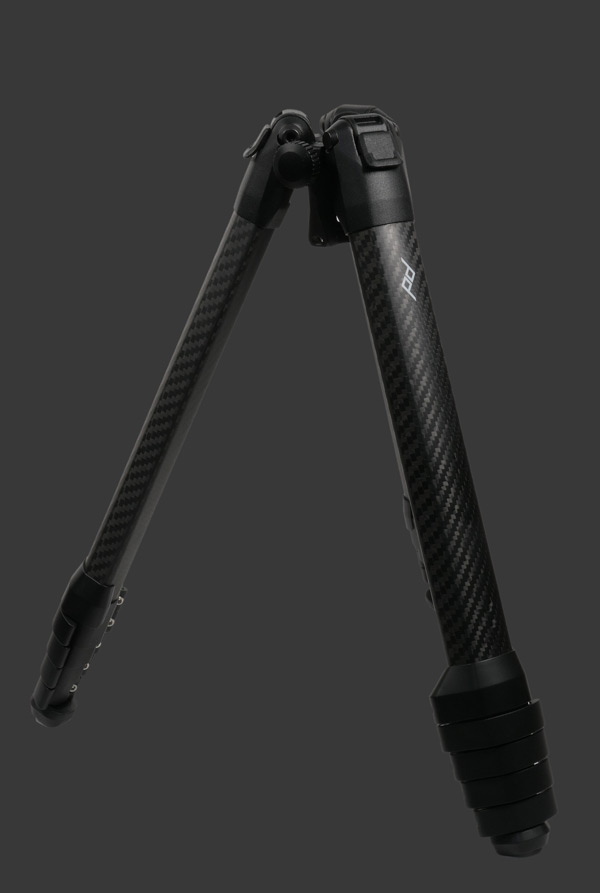
- Legs Only
- Legs & Adapter
- Legs, Adapter & Column
- Legs & Ballhead
- Legs, Ballhead & Column
Comparison
While it is easy to describe the Peak Design Travel Tripod by its specifications, the real achievement is in how it measures to the best rival tripod. Travel tripods are necessarily light, compact and versatile, just like this one.
The benchmark travel tripod has been the Velbon Sherpa Pro CF-645 launched in 2006. This Carbon Fiber 4-section tripod delivered the ultimate compromise in compactness and size. With a folded size of 42.5cm, it is the shortest tripod which extends to full height, 1.26m high with the center column down and up to 1.6m with it raised. It weighs 1.5kg in total yet just 1.3kg with the central column removed.
Peak Design ultimately surpassed this with their Travel Tripod! It collapses smaller to 39cm while extending taller to 1.31m without the central column or almost as tall to a maximum of 1.53m. With a collapsed diameter of 8cm, compared to 12cm for the Velbon, the Peak Design Travel Tripod occupies significantly less volume. This unique tripod varies in weight from 1.1 to 1.3kg. The minimum of 1.1kg is achieved with the tripod and head adapter but no central column. With the central column, it reaches 1.2kg, the same as the tripod plus supplied head but no column. The Travel Tripod weighs 1.3kg.when fitted with the supplied head and central column.
The modern competitor is the Gitzo GT1555T. This is the only 5-section tripod that closes shorter than the one from Peak Design. Collapsed, it measures 36cm in length but it does not reach the same height. Its maximum height with the central column down is 1.2m and 1.4m with it extended. Amazingly though it weighs just 1kg. There is a kit which includes a ballhead but that adds 0.4kg, letting the Peak Design Travel Tripod take the top spot for lowest total weight.
Usability
Peak Design seems to have worked very hard to make this tripod so compact while minimizing compromises on ergonomics. The main effort when setting up a tripod is to extend its legs and clamp them down securely. A number of leg extension mechanisms exist with levers or twist loops being the most popular. Levers are much more efficient and user friendly and so Peak Design chose those instead of twist loops which are generally found on travel tripods because those take less space.
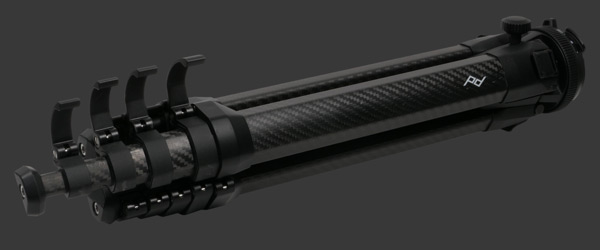
Each tripod leg has 4 levers with the same trapezoid profile as the leg itself. This allows them to point inwards instead of expanding the outline of the tripod. The way these levers are lined up makes it easy to open all of them in one hand motion. It takes a bit of practice to not miss the lowest lever. They have a good amount of resistance without requiring too much effort. Once these levers are fully opened, legs can be manually extended very quickly. They slide with virtually no effort. Closing those levers is even easier, particularly when the tripod is collapsed since all levers they can be closed all at once.
The central column is simple to extend. Just rotate the knob counter-clockwise to loosen, pull the column to the desired height and turn the knob clockwise to tighten. The knob can be pulled outwards slightly for a better grip, although this seems unnecessary. Perhaps when using the tripod in the cold while wearing gloves, it would make a difference. Make sure to tighten completely, otherwise the central column shakes easily.
To invert the central column, the hook at the end must be removed as it helpfully prevents the column from completely slipping out. Small arrows mark where to pull down. Twist from there to release. It is very easy. Inside the column, there is a cellphone mount with magnets on both ends that prevent it from falling out when the hook does not cap the column. The central column then comes out completely to be reinserted the opposite way. Reverse the process to uninvert.
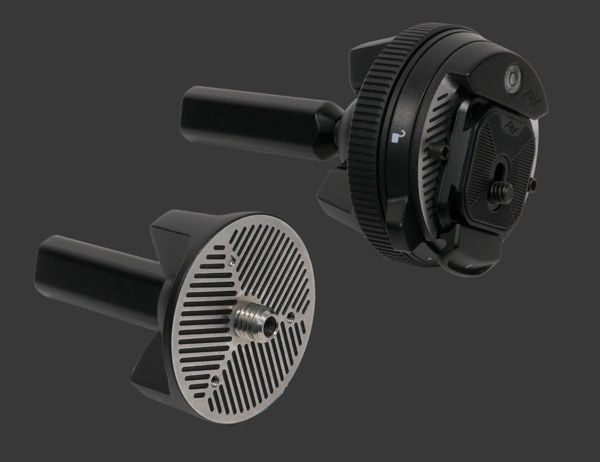
Using the included ballhead creates a very different experience when using the Peak Design Travel Tripod. For this reason, the remainder of this review section is split between usability with the built-in ballhead and with the Universal Head Adapter.
Peak Design Ballhead Usability
The supplied ballhead allows the tripod to close down significantly shorter than nearly every competing model. This unique ballhead just adds 2.5cm (1") to the collapsed size of the tripod! The way other tripod approach this is to rotate the legs 180° upwards. The question is whether its compromises are acceptable in exchange for this ultimate compactness. Those compromises are explained in detail right here.
Completely hidden under its quick-release clamp, the Peak Design ballhead fits precisely into the tripod. Three sturdy prongs hold the actual ball and line up between joints that connect each leg to the tripod hub. Only when the head is rotated correctly does it close down completely. Otherwise, the column remains extended by 2cm, preventing the tripod from fitting into its dedicated bag.
Optimal stability on any tripod is achieved with its central column down. While it is possible to use the Peak Design Travel Tripod this way, doing so can be frustrating because the ballhead cannot rotate unless the column is raised. To level the camera then, one must adjust individually and precisely adjust the length of each leg. There is no way to insert a leveling base between this ballhead and the tripod either.
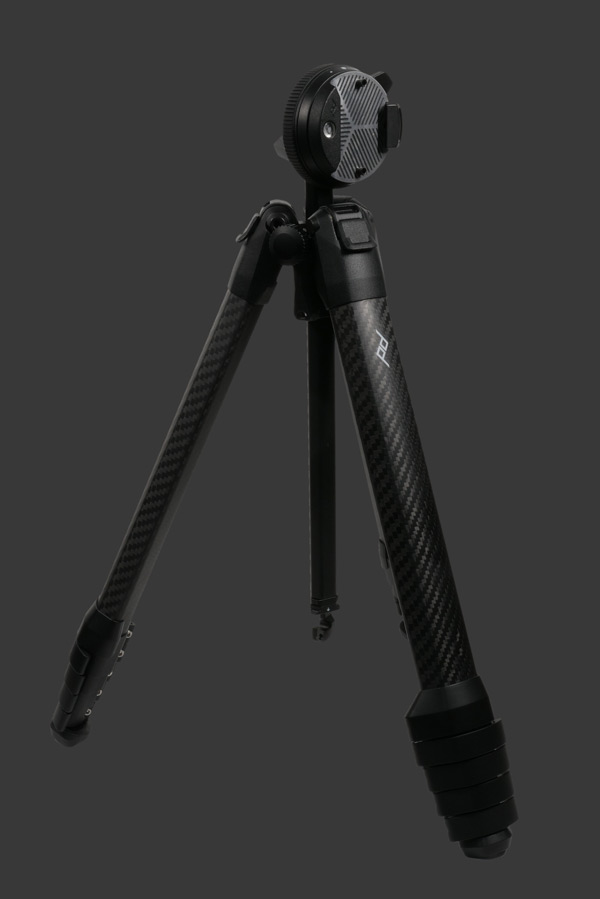
When the central column is extended by at least a few centimeters, orienting the camera becomes much easier. Turning the only ring at the base of the ballhead counter-clockwise frees the head to rotate in any direction. In order to get the full range of motion and achieve portrait orientation, the column must be extended 4.5cm or more. With the main tube removed, this leaves about 2cm of extension before falling out.
Turning the ring clockwise quickly immobilizes the ballhead. This impressive mechanism locks the head securely without any drift. The ring has a ribbed texture that makes it easy to grip. There is always some friction in the mechanism which prevents the head from dropping quickly when the mechanism is not fully locked.
Although the mechanism is simple, it takes practice to master it. Pointing the camera works like with any other head. The main trick is to rotate the ring while keeping the angle constant. Readjusting a camera already mounted on the tripod requires even more care because there is no independent pan control. When reframing to capture slightly different images from the same position, it is very easy to unintentionally tilt the camera which can go unnoticed since the spirit-level gets obstructed. This certainly the most frequent usability issue.
The Arca-Swiss compatible quick-release clamp grabs the quick release plate on two sides. This is the case for many plates but Peak Design warns that plates relying on 3 contact-points are incompatible with their clamp. While the mechanism is simple, a lot of force is required for the plate to push its way into the clamp. One must first place the front-edge in fully, pointing the camera lens slightly downwards, and then press the back down until the loud click of the clamp is heard. Care must be taken to avoid accidentally moving the tripod.
There are two imprecisions to this setup. One is that the screw on the plate is not fixed in place and the other is that the wiggle room in horizontal orientation mentioned before. This is an issue for trying to get consistent framing among several shots when the camera needs to be unmounted between. Regardless, the grip on the plate is strong. It becomes extremely secure when a locking ring at the base of the clamp is moved to the locked position.
To connect the supplied ultra-low profile quick-release plate, a hex key is required. The screw is recessed at the bottom of the plate which makes it difficult to turn by hand. It also lacks a slot for using a coin or house key to tighten. It is very light and small enough to be left mounted on a camera. Additional Standard Plates are available for purchase from Peak Design. They also sell a more versatile Dual Plate that is compatible with both Arca-Swiss and Manfrotto RC2 clamps. Numerous quick-release plates exist from other manufacturers. A few are universal but most are specifically designed for certain cameras, allowing them to provide a custom fit.
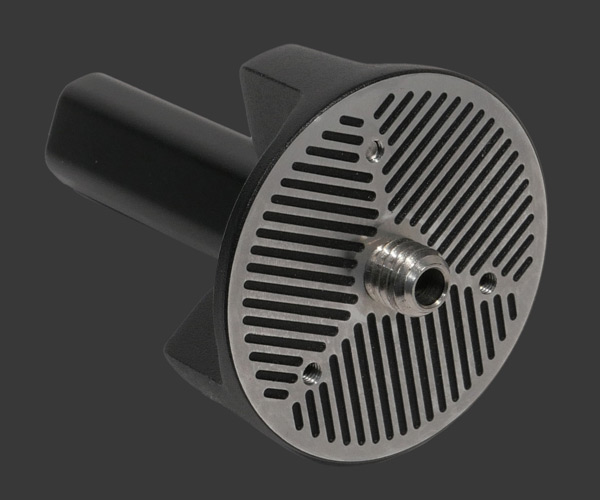
Universal Head Adapter Usability
The Universal Head Adapter changes everything. It takes less than 30s to swap the built-in head for the adapter using the provided hex-tool. Once installed, the tripod itself becomes 100g lighter before adding a standard ballhead. Those are generally heavier than 100g, so total weight increases and so does its folded length. The result is still light and compact yet with improved usability.
Installing any head onto the Universal Head Adapter is trivial. Just spin it over the top-plate until it is securely attached. A leveling-base can be inserted just as easily. Retractable studs can be extended to secure the new head using the other side of the provided hex-tool.
When mounted on the adapter, a tripod head is entirely above the tripod. Although this makes the tripod taller and longer when closed, its central column can be kept completely down while retaining a full motion-range. This instantly provides superior stability. As always, this is a compromise. Photographers that require this level of stability can remove the main tube of the central column. While it only saves 75g, the tripod gains access to a lower position, only 14cm (5.5") from the ground for dramatic compositions. With the central column installed, the minimum height is 27cm (11") with the hook removed or 30cm (12"), otherwise.
There are four disadvantages to removing the column. Two because the bottom of the adapter is uncappedSame for the bottom of the included ballhead.: the column can slip out easily and dirt can get stuck in the tubbing. A rubber cap accessory would be great! At least, the risk of slipping is low for those who never extend the column. The other two because the hook cannot be fixed to the adapter: no hook to weigh the tripod down and a strap attachment point goes missing. Of course, a lower minimum shooting height and lower weight are great compromises for this.
Any head can be attached using the Universal Head Adapter. This includes ballheads with various types of attachments, quick-release systems, geared heads, panoramic heads and more. A few suggestions are shown in the purple box on the right, or below for those reading this review on a mobile device. Just note that the tripod will no longer fit into the included bag when a head is attached.
Conclusion
Peak Design successfully created the most remarkable tripod of recent years. Their Travel Tripod really shines for its unprecedented compactness. When closed down, it is one of the shortest tripods on the market, just 39cm long. More impressively, it fits within an 8cm diameter which is better than any tripod. Even though it collapses into such a small space, it extends tall to 1.3m without the central column or 1.5 with it fully extended.
The Carbon Fiber version is light at 1.3kg even with the included ballhead. A slightly heavier Aluminum model is available at a lower-cost yet is just as compact. Regardless of material, the Peak Design Travel Tripod is the tripod to buy to minimize bulk. This is a very stable tripod that is very well-built and has a nice high-quality finish.
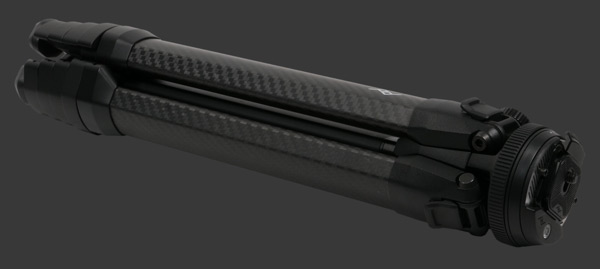
One of the most innovative component is the included ball-head that is designed to add the least amount of bulk. This ballhead provides great support and it locks firmly in place without any drift. Its integrated Arca-Swiss quick-release clamp fits many plates, including an ultra-low profile one supplied with the tripod. A few compromises were required to build this head, including just have a single control for all movement and the need to extend the central column. When it comes down to size, this is an unbeatable ballhead.
An optional Universal Ballhead Adapter trades certain compromises taken by the included ballhead for exceptional versatility, while necessarily resulting in a slight longer tripod and higher total weight. While the adapter itself makes the tripod lighter, many ballheads would add back more weight. Overall, this combination delivers the very best travel tripod experience with minimal compromises.
The Peak Design Travel Tripod is relatively expensive yet provides a number of accessories, including its unique ballhead with quick-release clamp plus ultra-low profile plate, a universal cellphone holder and padded waterproof tripod bag. It is really only missing a strap. The Universal Ballhead Adapter sold separately adds a reasonable amount to the total price. One gets a tripod head regardless, which might be seen as wasteful. Either way, this unique tripod is clearly a winner for travel photographers.
| ADVANTAGES | DISADVANTAGES TRIPOD ALONE | DISADVANTAGES HEAD |
|---|---|---|
| Incredibly compact when closed | Central column not rotatable | Requires central column raised |
| Extends to a reasonable height | Hook requires central column | Difficult to orient precisely |
| Highly efficient to extend | Strap requires central column | Unreadable level |
| Quick to close down | Bag only usable with own head | Camera obstructs level |
| Light weight for its height | ||
| Excellent stability | ||
| Superb build quality | ||
| Invertible and removable column | ||
| Versatile add-ons |
Please Support Neocamera
All information on Neocamera is provided free of charge yet running this website is a huge endeavor. Purchases made via affiliate links found throughout the site help keep it running and up-to-date. There is no additional cost to you, so please consider buying via these links to our affilates:
Thank you for your support!
Ballheads
The unique ballhead included with Peak Design Travel Tripods offers minimal control to save space and weight. Once it is swapped with the Universal Head Adapter, any standard head can be mounted onto the tripod.
Considering this is a Travel Tripod, most photographers and videographers are expected to opt for a relatively lightweight head. For photography, ballheads are most convenient. Geared heads are another option but they are generally heavier and bulkier. Video users are better served by a fluid pan-head. Below are some highly recommended tripod heads.
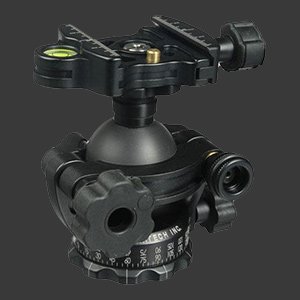
Acratech GP-SS
This premium ballhead distinguishes itself by being among the lightest thanks to the Acratech open-head design which requires less material. It weighs in at 380g and stands 9.4cm tall. The Acratech GP-SS supports 11kg (25lbs) and comes with an Arca-Swiss style quick-release clamp but no plate. There are two variants with spirit levels in different places yet both are awkwardly placed.
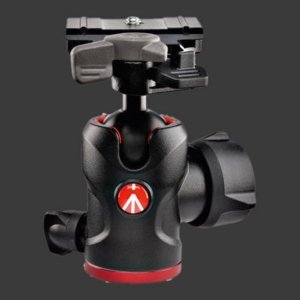
Manfrotto 494 Center Ballhead
A high-quality ballhead that supports 8kg while weighing 330g. The Manfrotto 494 features tilt and pan knobs to control each movement independently. There is even a friction control to adjust depending on the mounted camera. It comes with an ingenious quick-release clamp that accepts an RC2 or Arca-Swiss plate. The RC2 system is one of the most robust and efficient available. In fact, Peak Design also makes plates compatible with both. This ballhead is 10cm high.

Gitzo GH1382TQD Traveler Series 1
Another high-quality ballhead with independent tilt and pan control. This one holds 11kg and weighs 390g, while being 10.4cm tall. The Gitzo GH1382TQD features the best-designed Arca-Swiss clamp of the group, one that places the built-in spirit-level in a visible position at all times. It is slightly taller but narrower than the Acratech GP-SS.
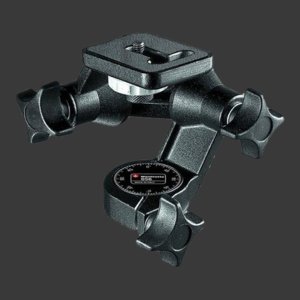
Manfrotto 3D Junior
Ultimate precision generally requires a heavy geared head. At 550g (1.2lbs) this is the exception. This is still not a light tripod head but the Manfrotto 3D Junior provides precise individual control over 3-axis. It measures about 10cm high. This head does not feature a quick release clamp or spirit-level.
Updates
2025.11.13

Best Gifts for Photographers in 2025 by Budget
The annual Neocamera Photography Gift Guide updated to 2025. Find great gifts for photographers with any price budget.
2025.07.07

Stellar Photo Recovery Review
Review of Stellar Photo Recovery V12. This Windows and MacOS software can recover photos and videos in a huge number of formats from memory cards, USB drives, SSDs and HHDs.
2025.05.14

Huion Kamvas 13 Gen 3 Review
In-Depth review of the Huion Kamvas 13 Gen 3 Pen Display Tablet for photographers and graphic artists.
2025.01.18

Fujifilm GFX 2025 Lens Roundup
Lens Review roundup of Fujifilm GFX Medium-Format lenses. Quality, performance and handling of the GF20-35mm F/4R WR, GF30mm F/3.5 Tilt-Shift and the GF55mm F/1.7.
2024.11.18

Best 2024 Photography Gifts for Every Budget
Great gifts for photographers and photo enthusiasts selected for every budget among the best products of 2024.
2024.08.07

Eye Protection Tips for Professional Photographers
The four main considerations for professional photographers regarding eyewear.
2024.07.14

Fujifilm X100VI Review
Flagship fixed-lens compact digital camera with a 40 MP sensor and Image-Stabilization, a first for the series. Retro design featuring dual control-dials, plus direct ISO, Shutter-Speed and EC dials. Its hybrid viewfinder can switch between EVF and OVF mode.
2024.05.09

Fujifilm GFX100 II Review
Flagship 102 Megapixels Medium-Format Mirrorless Digital Camera with 8-Stop 5-Axis IBIS, 8 FPS Drive, 8K Video and 400 MP Super-Resolution capture in a weatherproof and freezeproof body with dual control-dials and dual memory-card slots.
2024.04.03

Fujifilm X-T5 Review
Newest Fujifilm flagship boasting a 40 MP APS-C sensor, 5-axis IBIS with 7-stop efficiency, 15 FPS continuous drive, 6.2K Video capture, dual control-dials and dual SDXC UHS-II slots in a sturdy weatherproof and freezeproof body.
2023.11.20

Best Digital Cameras of 2023
Find out which are the Best Digital Cameras of 2023. All the new Mirrorless Digital Cameras from entry-level to high-end professional.
2023.07.10

Fujifilm X-H2 Review
40 Megapixels APS-C Hybrid Mirrorless Digital Camera with 7-stop IBIS. Fastest shutter ever and 8K video capture. Large builtin EVF with 0.8X magnification and 5.8 MP, plus an Eye-Start Sensor. Packed with features and large number of controls in a weatherproof and freezeproof body.
2023.05.07

Sony FE 20-70mm F/4G Review
Review of the unique Sony FE 20-70mm F/4G lens. The optical zoom of this lens spans ultra-wide-angle and medium focal-length coverage, making it one of the most versatile Full-Frame lenses on the market.
2025.11.13
2025.07.07
2025.05.14
2025.01.18
2024.11.18
2024.08.07
2024.07.14
2024.05.09
2024.04.03
2023.11.20
2023.07.10
2023.05.07
NEWS
2025.12.02

Sony Upgrades Alpha 7 to 5th Generation
Digital Camera ○ Lens
2025.11.29

Venus Optics Releases New Zero-D Tilt-Shift Macro Lens
Lens
2025.11.23

Best Digital Cameras of 2025
Digital Camera
2025.11.14

Photography Gift Guide 2025 Edition
2025.11.06

Canon Announces Third-Generation R6 Mirrorless
Digital Camera ○ Lens
2025.10.23

Fujifilm Launches X-T30 III Plus New Wide Zoom
Digital Camera ○ Lens
2025.10.21

Peak Design Unveils Field Plate and Form Straps
2025.10.16

Nikon Unveils Z-Mount DX Lens Duo
Lens
2025.10.16

Venus Optics Unveils Fast Telephoto Prime Lens
Lens
2025.10.01

Think Tank Photo FocusPoint RollTop Backpacks
Bag
2025.09.30

Sony Produces Super Macro GMaster Lens
Lens
2025.09.17

Venus Optics Created First Telephoto Ultra-Macro Lens
Lens






